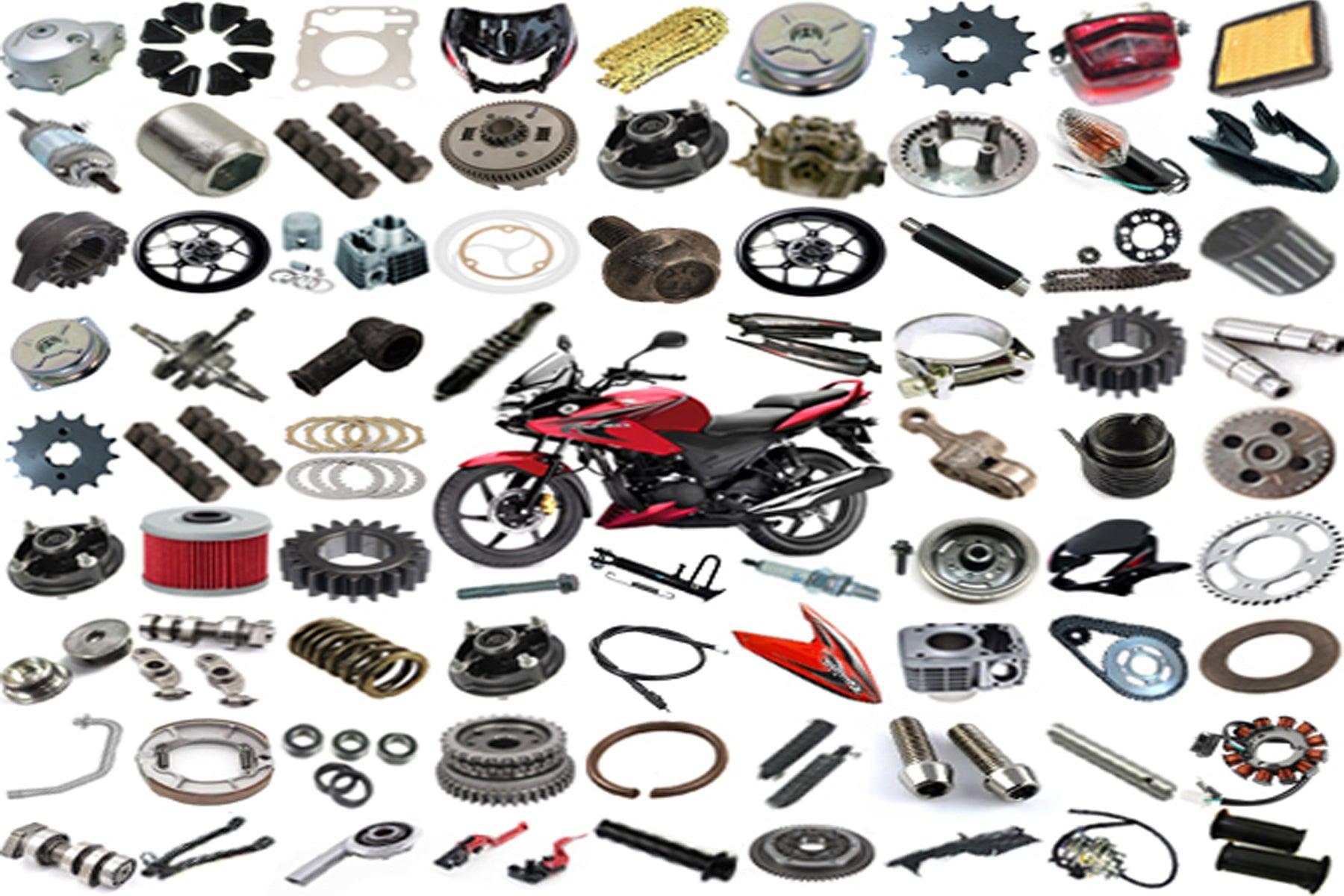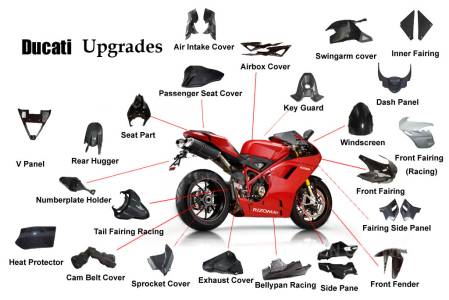Why Regular Checks on Motorcycle Spares Christchurch Prevent Breakdowns
Wiki Article
A Comprehensive Guide to Picking the most effective Bike Components for Your Adventure
Choosing the best bike parts is crucial for any type of bicyclist. Each element plays a substantial function in boosting efficiency and comfort. Comprehending the type of bike and its intended usage is essential. From handlebars to tires, every detail matters. This overview will certainly explore the essential elements of selecting these parts. The appropriate options can elevate any kind of trip, however what details aspects should one take into consideration to accomplish the most effective results?Recognizing Bike Types and Their Parts
Just how can one pick the best bike components without understanding the various sorts of bikes? Each bicycle kind-- mountain, cruiser, road, and hybrid-- attributes one-of-a-kind parts tailored to its particular function. Mtb, for circumstances, are outfitted with robust frames and bigger tires for off-road security, while road bikes focus on lightweight products and aerodynamic styles for rate on paved surfaces.Hybrids blend elements from both hill and road bikes, supplying convenience for different surfaces. Cruisers, designed for convenience, attribute larger seats and handlebars for an extra unwinded riding setting. Each type additionally makes use of distinctive equipment systems, brakes, and wheels that deal with their desired use.Understanding these differences is essential for choosing effective and compatible bike components. A biker's selection can significantly improve performance, safety, and overall pleasure. By recognizing the qualities of each bicycle kind, one can make enlightened decisions when updating or replacing components.Trick Considerations for Picking Handlebars
When picking handlebars, a cyclist has to take into consideration numerous aspects that can substantially affect convenience and control. One main factor to consider is the size of the handlebars, as it affects stability and take advantage of during experiences. Wider handlebars typically provide much better control, specifically in technological surfaces, while narrower ones may enhance the rules of aerodynamics for racing.Additionally, the surge or drop of the handlebars affects the biker's position. Higher handlebars promote a more upright position, lowering strain on the back, while lower ones can improve aerodynamics. The shape of the handlebars is also essential; alternatives like flat, riser, or decline bars accommodate different riding styles and preferences.Material is one more essential factor, with aluminum and carbon fiber being prominent for their equilibrium of weight and longevity. Ultimately, the best handlebars need to straighten with the motorcyclist's intended usage, guaranteeing a efficient and satisfying biking experience.
Selecting the Right Saddle for Convenience and Efficiency
Selecting the right saddle is essential for taking full advantage of comfort and performance during rides. A well-chosen saddle can significantly affect a cyclist's experience, directly affecting power degrees and total enjoyment. When selecting a saddle, elements such as width, form, and cushioning should be very carefully thought about. The saddle's size have to straighten with the cyclist's rest bone dimensions, ensuring appropriate support. Furthermore, padding preferences vary among cyclists; some might like minimal padding for an extra straight connection to the bike, while others might seek plush cushioning for enhanced convenience on longer rides. Saddle shape likewise plays a crucial duty, as it impacts the circulation of pressure during pedaling. Furthermore, products made use of in construction can impact weight and toughness. Inevitably, testing different saddles is important, as personal comfort varies greatly. A thoughtful approach to saddle choice can lead to improved performance and an extra delightful cycling experience.The Importance of Quality Tires for Various Terrains
Selecting the ideal tires is necessary for optimal efficiency across numerous terrains. Various surfaces demand certain tire features, such as step patterns and rubber substances, to assure traction and resilience. In addition, the long life and durability of tires can substantially affect a cyclist's general experience and safety and security on the roadway or trail.
Terrain-Specific Tire Includes
How does the surface effect tire efficiency? Various terrains call for distinct tire features to enhance efficiency and safety and security. Hill biking on rough routes demands tires with aggressive walk patterns to offer hold and stability. Conversely, road cycling on smooth surface areas benefits from narrower tires that decrease rolling resistance.In wet or muddy conditions, tires designed with much deeper grooves can direct water efficiently, protecting against hydroplaning. Additionally, softer compounds may boost traction on glossy surfaces, while harder compounds offer longevity on rough paths. Understanding these terrain-specific tire features is important for bikers intending to boost their riding experience. Picking the proper tire not only effects managing yet also general comfort, making it vital for riders to match their tires to their designated terrain.Tire Durability and Efficiency
Quality tires substantially affect a bicyclist's performance and safety and security across various surfaces. The longevity of tires is vital for holding up against the rigors of different surfaces, from sturdy routes to smooth roads. Better tires frequently include strengthened sidewalls and advanced rubber compounds, which enhance their durability and grasp. Tires created for off-road conditions typically have deeper treads that give better traction on loose surface areas, while road tires prioritize a smoother profile for decreased rolling resistance. In damp problems, tires with specialized tread patterns can improve handling and reduce the risk of hydroplaning. Ultimately, buying high quality tires tailored to specific riding atmospheres can significantly boost overall cycling experience, ensuring both efficiency and safety.Gearing Equipments: Discovering the Perfect Fit for Your Riding Style
While lots of bikers comprehend the relevance of a great bike frame or wheels, the gearing system plays an essential duty in improving efficiency and convenience when traveling or trail. Selecting the right tailoring system depends largely on specific riding design and terrain. As an example, roadway bicyclists usually gain from a compact tailoring setup, enabling for smoother shifts and greater speeds on level surface areas. In comparison, hill cyclists might prefer a bigger series of equipments to take on steep climbs up and rough descents.Cyclists need to likewise take into consideration the number of gears; a 1x system simplifies changing and decreases weight, while a 2x or 3x system uses adaptability for different surfaces. Recognizing equipment proportions is essential, as lower ratios promote easier pedaling uphill, while higher ratios support rate on flat stretches. Inevitably, the excellent gearing system balances with the biker's choices, ensuring a reliable and pleasurable cycling experience.Enhancing Your Trip With the Right Brakes
Choosing the ideal stopping system is as crucial as picking the best gearing for a bike. The high quality and kind of brakes can significantly influence a bicyclist's control, security, and general riding experience. Bicyclists often deal with a selection between rim brakes and disc brakes. Rim brakes are usually lighter and less complicated to preserve, making them a prominent option for roadway bikes, while disc brakes supply remarkable quiting power and performance in different weather, perfect for mountain bikes and visiting setups.Moreover, brake pads play an essential role in braking effectiveness. Picking the best material-- such as natural, metal, or semi-metallic-- can improve performance based on riding problems and individual choices. On top of that, appropriate alignment and routine maintenance of the stopping system guarantee reputable performance and long life. Eventually, investing in the ideal brakes tailored to individual riding styles can improve security and enjoyment on every ride.Upgrading Devices for a Much Better Biking Experience
Upgrading accessories can considerably boost a cyclist's experience when traveling. Necessary safety equipment, such as headgears and lights, combined with convenience improvements like padded seats and ergonomic holds, can make a noteworthy difference. These upgrades not just boost safety and security but likewise promote much longer and a lot more delightful trips.Important Security Gear
Safety gear is an important element of a biker's arsenal, enhancing both security and comfort when traveling. Helmets are one of the most crucial item, greatly lowering the threat of head injuries in situation of a crash. High-visibility clothing and devices, such as reflective vests and lights, assure that bicyclists remain noticeable to motorists, specifically in low-light problems. Gloves provide hold and decrease the probability of sores, while knee and elbow joint pads can supply extra defense throughout drops. Selecting suitable footwear with a good grasp can additionally enhance security while biking. Purchasing quality safety gear not only promotes a safer experience yet likewise improves a bicyclist's self-confidence, allowing them to enjoy their cycling experience to the max.Comfort Enhancements and Upgrades
Cyclists usually look for to boost their riding experience beyond basic precaution. Convenience improvements and upgrades play an essential duty in accomplishing this objective. Among the most substantial upgrades is a high-grade saddle, created to provide maximum support and minimize discomfort during longer experiences. In addition, handlebar grips that provide far better functional designs can alleviate stress on wrists and hands. Purchasing padded biking shorts can additionally improve convenience by lessening rubbing and pressure factors. Shock-absorbing seat messages and larger tires can boost experience top quality by wetting vibrations read more from harsh terrain. Finally, readjusting the bike fit guarantees that settings are ideal for specific bikers, resulting in a much more enjoyable and comfortable biking experienceFrequently Asked Concerns
Just how Do I Preserve My Bike Components for Durability?
Keeping bike parts for long life entails normal cleaning, lubrication, and examination. Proper storage space far from dampness, timely substitute of worn elements, and adherence to maker standards can substantially enhance the life-span and efficiency of the bicycle.What Tools Do I Required for Bike Part Installation?
To set up bike parts successfully, one normally calls for essential tools such as wrenches, screwdrivers, tire bars, a multi-tool, and a pump. These instruments promote correct setting up, making certain perfect performance and durability of the bike components.
How Commonly Should I Change Bike Elements?

Can I Mix and Match Components From Different Brands?
Matching and blending bike components from different brands is feasible, but compatibility is crucial (Bike Parts Wellington). Aspects like measurements, materials, and design ought to be considered to assure peak efficiency and security, highlighting the importance of research prior to any type of mixWhat Are the Indicators of Damaged Bike Parts?
Indications of damaged bike components consist of uncommon sounds during trips, reduced performance, noticeable damages such as fractures or rust, and difficulty moving gears. Normal assessments can assist determine these issues before they endanger safety and security and efficiency. Mountain bikes, for circumstances, are furnished with durable frames and broader tires for off-road security, while road bikes prioritize light-weight materials and wind resistant layouts for speed on paved surfaces.Hybrids mix aspects from both hill and roadway bikes, supplying flexibility for varied terrains. Conversely, road cycling on smooth surfaces benefits from narrower tires that minimize rolling resistance.In wet or muddy conditions, tires designed with deeper grooves can funnel water efficiently, preventing hydroplaning. Understanding these terrain-specific tire functions is crucial for cyclists aiming to improve their riding experience. Tires made for off-road conditions typically have much deeper treads that give far better traction on loose surfaces, while roadway tires prioritize a smoother account for decreased rolling resistance. To set up bike components properly, one normally requires vital tools such as wrenches, screwdrivers, tire bars, a multi-tool, and a pump.Report this wiki page